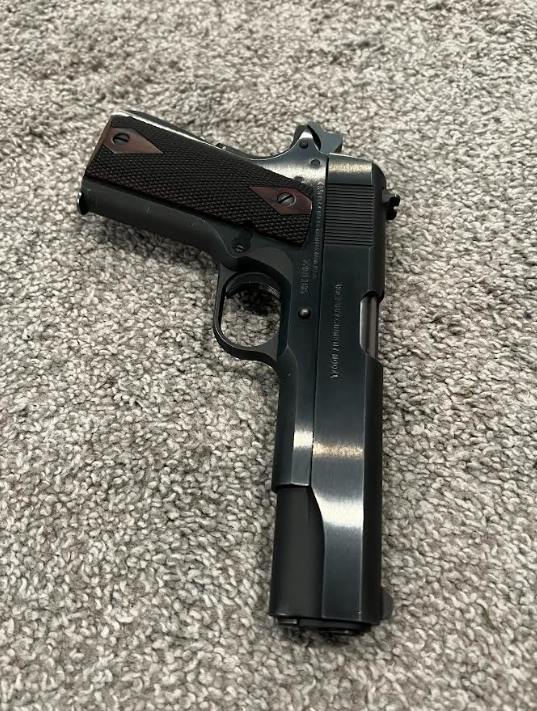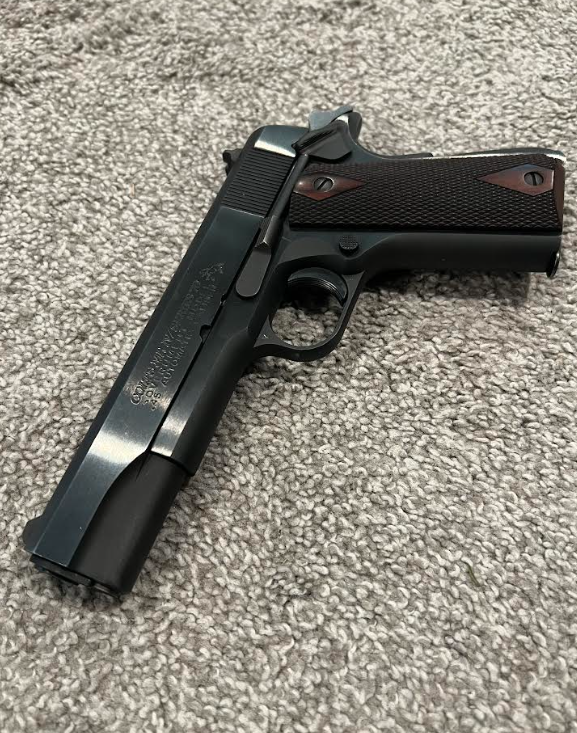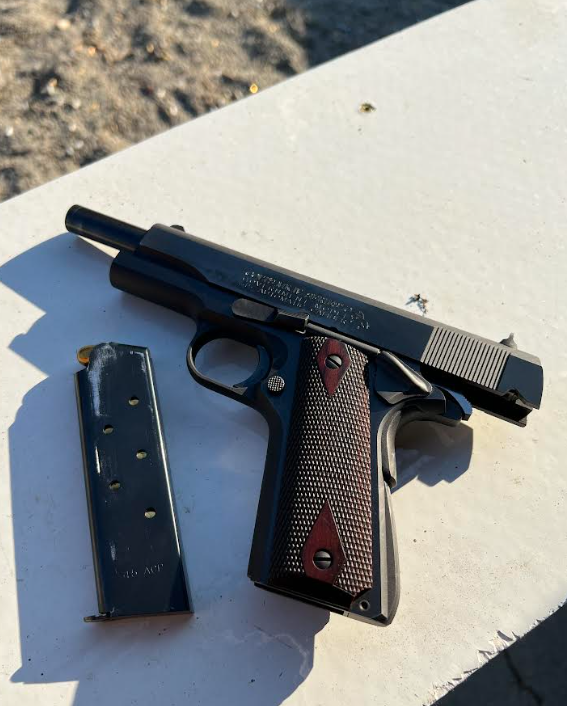Some designs fade with time and others get reinvented, but the 1911 is one gun that just refuses to go away.
More than a hundred years old, this pistol is still one of the most popular semi-automatic pistols in America. In fact, when you add up all the companies making 1911s today (Colt, Springfield Armory, Smith & Wesson, Ruger, Kimber, Dan Wesson, Taurus, SIG Sauer, Rock Island Armory, and plenty more) they collectively outsell Glocks on the civilian market.
That’s not nostalgia talking. That’s cold hard numbers. The 1911 may be old school…but sometimes old school is cool.
The 1911 has managed to hang around because it works. It’s accurate, it’s comfortable to the point of feeling super natural in the hand, and the .45 ACP cartridge it was designed around is still a proven fight-stopper.
In a world of striker-fired polymer pistols, the 1911 still remains a more than viable choice for home defense, for the range, and for the woods.

The Colt Mark IV Series 70 in .45 ACP maintains the classic appearance and feel of the classic Colt M1911A1.
But why?
My personal 1911 is a Colt Mark IV Series 70 in .45 ACP. I’ll use it as an example to help pinpoint what has made the 1911 such a remarkably successful pistol even after more than a full century in use.
The Merits of the 1911 Pistol
The 1911 chambered in .45 ACP has always had a reputation as a serious fighting pistol, and that reputation is well earned.
The .45 ACP cartridge is a heavy (and slow-moving) round that has been proven over more than a century to put down threats quickly…regardless of whether that be a hostile person or a dangerous animal at close range.
The design of the 1911 itself helps tame that big cartridge, since the all-steel frame soaks up recoil and makes it surprisingly easy to control in rapid fire.
Practicality also matters, and the 1911 doesn’t fail in this department. It is slim and narrow compared to many modern pistols, which makes it easier to conceal despite being full sized.
Capacity is usually seven or eight rounds in the magazine, which is less than many polymer guns today, but spare magazines are nonetheless inexpensive and widely available. Because the 1911 has been around so long, parts are everywhere too, which means keeping one running is simple.
On top of that, it remains legal to own in all fifty states. So if you’re gonna go on a road trip in the future and want to bring a handgun with you, you can be rest assured that your 1911 (most likely) isn’t gonna be causing any problems even if you end up in a state with strict gun laws.
Why Colt?
There are some excellent 1911 makers out there today, and plenty of them make fine pistols. Springfield Armory makes some great options, Ruger puts out a reliable and affordable 1911, and Smith & Wesson has a strong following too.
But when I was shopping for mine, I wanted the original name on the slide. I wanted to be able to say I owned a Colt 1911.

The blued finish and wooden grips of the Colt Series 70 are super gorgeous. The gun is very bit a work of art just as much as it is a weapon.
Maybe my ego got in the way a little bit, but there’s something satisfying about holding a Colt and knowing that you’re shooting the same brand that armed American servicemen from World War I through Vietnam.
Colt’s reputation for reliability played into my decision too. They’re far from the only good 1911 company, but they’ve been doing this a long time, and they know how to build a pistol that runs.
Classic Lines, Classic Feel
The Series 70 is a throwback in all the right ways. It keeps the look and feel of the classic M1911A1 that was carried by servicemen through World War II, Korea, and Vietnam. That’s the look I love. I don’t need a modern beavertail grip safety or an extended thumb safety, and I don’t want a flat mainspring housing. Give me the GI-style setup every time.!
You see, I prefer the shorter trigger, the arched mainspring housing, the standard grip safety, and the short thumb safety. That’s the 1911 I picture in my mind when I think of the pistol. The Series 70 delivers exactly that: a pistol that looks and feels like the one our grandfathers carried into battle.
Series 70 vs. Series 80
One of the reasons the Series 70 is so beloved is the firing system. Colt’s Series 70 uses a simple design without the additional firing pin safety parts that was found in the later Series 80 models. The Series 80 adds a passive firing pin block that’s disengaged by the trigger pull.
In theory, it’s a safety improvement, but in practice, it adds extra parts and a slightly heavier (and less crisp) trigger pull that’s just not quite as smooth and satisfying as can typically found on a Series 70-style gun.
The Series 70 doesn’t have those parts, so the trigger feels cleaner and lighter. It’s simpler and it’s less complicated, and for a lot of 1911 fans, that’s the way the gun was meant to be.
A Pistol That’s At Home in the Woods
Most folks think of the 1911 as a defensive sidearm, and it certainly excels in that role, but I’ve found it’s also a solid companion for the outdoors.

I’ve routinely carried my 1911 as a sidearm while hiking or hunting out in the woods, and I’ve never felt underarmed.
I carry mine as a woods gun while hiking or hunting pretty often, usually alternating between the Colt Series 70 and my Ruger GP100.
It just depends on my mood…sometimes I want .45 ACP with a spare magazine, sometimes I want six rounds of .357 Magnum revolver with a speedloader.
Both are equally capable of keeping you safe from whatever critters in North America you might stumble across. For a long time, before the bigger Magnum revolvers were introduced, .45 ACP and .357 Magnum were two of the most powerful cartridges available (along with the .45 Long Colt, from which the ACP round was derived). So for that time, people had to rely on either a .357 Mag or a 1911 in .45 to keep themselves safe in a close encounter with a cougar or a wolf or even a bear.
Close Encounters with the Colt 1911…
I’ll tell you one story.
One day I was hiking alone in the mountains, carrying my .30-06 rifle slung on my shoulder and my Colt 1911 in .45 ACP on my hip. The trail was quiet and the woods were thick, the kind of place where you feel both peace and tension because you know you are not the only living thing out there.
Sure enough, as I was descending a brushy ravine, I came face to face with a mother black bear and two cubs.
She stood up on her hind legs (taller than me by far!), and looked straight at me. For a moment we locked eyes, and I froze in place.
My mind raced. I thought I might get off a single shot with the .30-06 before having to drop it and draw the Colt, ready to empty the magazine if things went bad in the next few seconds.
But that fight (thankfully!) never came. After a few tense seconds she dropped back down, turned, and ushered her cubs up the mountainside and ran up with them.
I stood there motionless for a little bit before I slowly began to descend the hillside, still gripping the rifle and grateful that neither she nor I had to find out how much damage a .45 ACP could do in such a close-quarters encounter!
A Hunter’s Companion
I also used my Colt Series 70 to finish off an elk. Now, I didn’t drop the animal with it…that took a couple of well-placed rifle rounds.
But when the animal was down, I stepped up with the 1911 to deliver the coup de grâce. One .45 ACP round and it was over, quick and clean.
Every hunter needs a good sidearm, and the 1911 is a more than capable choice.
Caliber Choices for the 1911
These days, the 1911 isn’t just a .45. You can also get them chambered in 9mm or 10mm,and even some boutique calibers like .38 Super. The two most common alternatives are 9mm and 10mm, however.

The Series 70 with a fresh load of .45 ACP at the range and ready to go.
The 9mm version has its merits…I suppose it’s easier to shoot, a bit cheaper to practice with, and it gives you a couple more rounds per magazine. The 10mm version (like the Colt Delta Elite) is a powerhouse, and it makes a great option for a hunting sidearm or backcountry defense.
But for me, the 1911 is .45 ACP, through and through. That’s the cartridge it was designed around, and it just feels right.
Why the 1911 Still Belongs Today
So why carry or shoot a 1911 in 2025, when there are lighter and higher-capacity pistols all over the market?
Simple: because it still gets the job done. The ergonomics of the 1911 are very natural despite it being an older design. The single-action trigger is crisp and predictable. The slim frame carries flatter than many modern pistols. And while 7 or 8 rounds of .45 ACP doesn’t sound like much compared to a Glock 19’s 15 rounds of 9mm, those big slow bullets are still plenty effective and you don’t have to worry if you’re in a state with magazine restrictions.
The 1911 also has something that polymer pistols never will: character. A Colt 1911 feels like history in your hands. It’s a well-regarded piece of American tradition that still performs in the present

